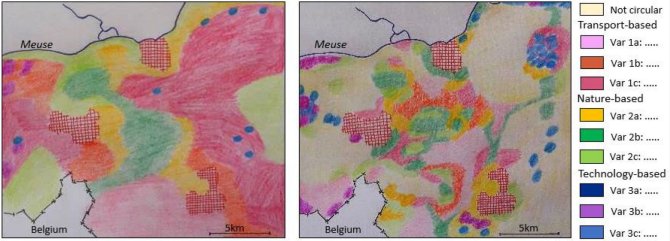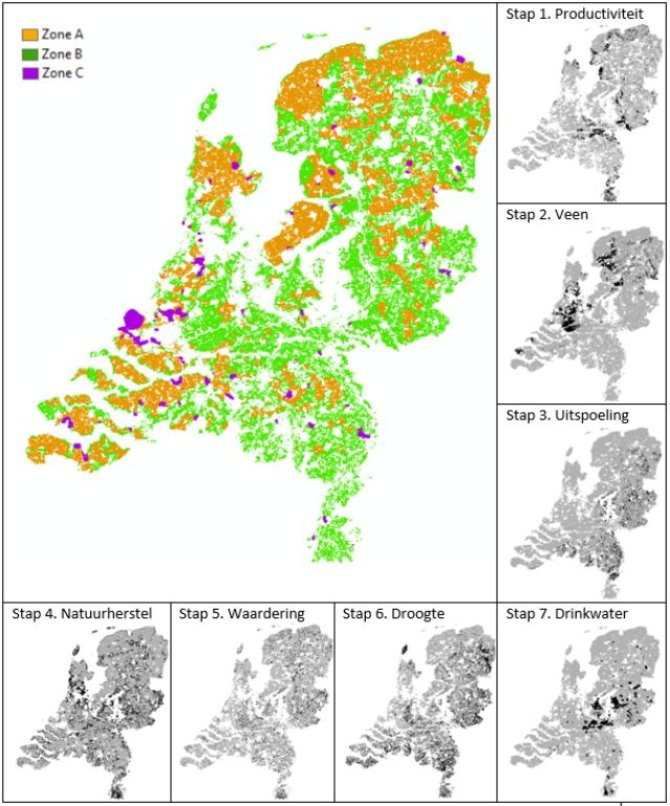SPLENDID: Spatial PLanning for ENvironmentally Diverse cIrcular Development (LSP)
Achieving sustainable circular, nature-inclusive or regenerative agriculture requires understanding spatial organisation of land use: the closer the source and destination of residues, the lower the costs and risks of transport, and thus the more viable residue exchanges and cycle-closing. Without efficient land-use organisation, converting to sustainable practices remains minimal—adopters of sustainable practices often remain at a disadvantage compared to conventional practitioners reliant on existing, efficient, cheap infrastructures, because spatial fragmentation of sustainable practices hampers potential synergies that could be achieved with clever organisation.
We expect massive adoption of sustainable practices, including partial closure of nutrient and carbon cycles, through rigorously reorganising land-use patterns. We envision diversity in circularity variants, derived from three circularity archetypes, each with a role to play. The degree to which different variants can achieve circularity may vary, but so will delivery of other important values (landscape quality, biodiversity). A crucial success factor for the plurality of variants is spatial coherence and matching surroundings. We take a landscape / ecosystem services (ES) approach to investigate how circularity takes shape, which ES are delivered by what circularity variant, and what spatial organisation yields the highest environmental quality.
SPLENDID hypothesises that circular agriculture can be grouped three ways: nature-based, (restoring natural cycles and regenerative farming); technology-based, (complementary non-land-based farms, such as livestock or horticulture, are combined in fully closed systems, to maximally re-use waste streams); and transport-based (farmers capture and upgrade their own waste for re-use or replace their input with others’ upgraded waste). Each implementation has a specific ecosystem service delivery profile; only in combination can we achieve the societally-desired palette.
Some SPLENDID research questions focus on circularity variant diversity and how to strike a balance between all ES:
- Which circularity archetype variants can be distinguished? What is their general ES delivery performance?
- How is each variant’s ES delivery affected by location/composition?
- How to mix circularity variants, and how to organise, to provide a wide range of ES?
Some questions focus on how to realise desired spatial organisation:
- Which land policy instruments exist to implement desired spatial organisation of circularity variants?
- How effective are instruments, given institutional (property and user rights), societal (public support) and financial (available budgets) constraints?
- Will new spatial organisation be viable? How to redirect gains in ES to farmers, and what supporting institutional regime is required to secure clusters?
There will be three workshops to involve stakeholders in these questions. Preparation for the first workshop entails system analysis, stakeholder analysis, collection of GIS data, a short documentary presenting circularity variants (including a provisionally ES profile) and an interactive software environment. In the workshop, circularity variants are discussed and adjusted based on stakeholder knowledge; we establish which ES to include and assess minimal delivery; smaller groups of participants are asked to distribute variants over the research area (i.e. a spatial design).
At the second workshop, stakeholders receive feedback on spatial designs as overall ES delivery. Groups may try to improve designs and receive feedback on the ES performance of their adjusted design; stakeholders are asked to reflect on (a) longlists of potential measures and define a coherent strategy and (b) the ABM prototype.
At the final workshop, researchers present final outcomes to stakeholders and illustrate effects of location, size and shape on ES delivery. Stakeholders explore, using PhD1 metamodel, how to improve designs. PhD3 presents the extent to which various designs are feasible, given area farmer ambitions. PhD2 presents the most successful policy strategies for achieving spatial designs: one from the point of view of maximising ES delivery; another, of achieving the largest societal support.
This research forms a crucial contribution to circular agriculture’s actual implementation. The concept of circular agriculture has been received with great enthusiasm by many societal partners, but it is entirely unclear how to implement it at a scale exceeding the individual farm or cooperative. Without a clear implementation strategy, the circular agriculture vision published by the Ministry of Agriculture, Nature and Food Quality tends to get stuck at the level of good intentions. We will provide this implementation strategy by delivering:
- an overview of different circular agriculture variants, accompanied by an ES delivery profile. Provincial planners can then make strategic zoning plans for the rural area.
- design principles for each circularity variant, selecting the appropriate location, optimising scale benefits and minimising negative externalities
- guidelines for redirecting ES gains back to land owners supplying them, hence ensuring viability of circular agriculture, including its less economically competitive forms
- coherent policy strategies to implement circular agriculture and prevent undesired developments (including guidelines for using the New Environmental Act and integration of the Rural Areas Development Act)
- a detailed reflection on pros and cons of a suite of land policy instruments for achieving desired zonation.

